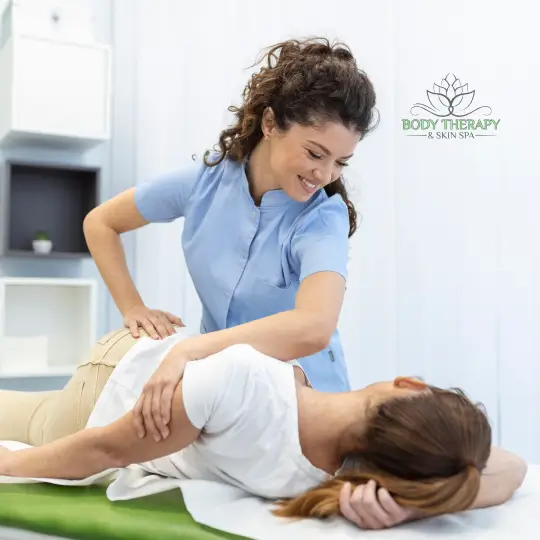Assisted stretching is a technique that uses external help. It increases the range of motion and flexibility. This type of stretching can help you improve performance in a variety of activities, from sports to yoga and dance. It can also help reduce the risk of injury and relieve muscle tension.
Assisted stretching has many benefits. Here are some helpful tips to do it correctly and safely. Additionally, we will share some common mistakes to avoid. Stretching correctly can help you get the most out of your workouts and have better performance.
Assisted Stretching Tips
When doing assisted stretching, it is important to warm up your muscles beforehand. This can be done through light cardio or dynamic stretching to properly prepare your muscles for the stretch. Once your muscles are warm, you can move on to various assisted stretching techniques.
Assisted stretching equipment can be helpful. Elastic bands and foam rollers can be used to get a deeper stretch and greater range of motion. When using this equipment, make sure to use the appropriate amount of pressure for your muscle group and body type.
Finally, make sure to pay attention to any pain you experience during the stretch. If it becomes too intense, adjust the pressure or take a break. When incorporating dynamic stretching into your routine, make sure to stop before fatigue. Breathe deeply and remember to relax your muscles.
Common Assisted Stretching Mistakes
There are numerous common mistakes people make when engaging in assisted stretching. To maximize the effectiveness of s retching, it’s important to be aware of some of the pitfalls.
Not warming up before stretching can result in injury, as can stretching for too long. Similarly, not using the appropriate amount f pressure when stretching can lead to straining the muscles.
Further, failing to use proper technique when stretching can lead to overstretching and cause discomfort or injury. It’s important to be mindful when engaging in assisted stretching and to consider what is best for your body.
Additional Assisted Stretching Tips
Whether you’re an athlete, dancer, or yogi, adding assisted stretching to your routine can provide numerous benefits. To maximize the benefits of assisted stretching, it is important to pay attention to pain and adjust the stretching technique accordingly. Knowing when and how to use dynamic stretching is also important, as it helps to increase flexibility and range of motion. Finally, don’t forget to breathe while stretching; a slow, controlled breath can help to deepen the stretch.
With the proper knowledge and technique, assisted stretching can be a great way to improve flexibility and enhance performance. By following these additional tips, you can maximize the benefits of assisted stretching and better prepare your body for any activity.
Safety Considerations
When doing assisted stretching, it’s important to take safety into account. Avoid stretching to the point of pain, and never stretch cold muscles. Pain is an indication that you should stop and adjust accordingly.
It is recommended to have a spotter when doing partner-assisted stretching. This is because it can be difficult to ‘salo, control the amount of pressure applied when stretching alone.
To get the most out of your assisted stretching, follow safety considerations. This will help you avoid potential injuries.
Pay attention to pain and adjust your stretching accordingly. Understand when and how to use dynamic stretching.
Follow safety considerations to ensure that you are stretching properly. Remember to perform, pause, and do dynamic stretching. Don’t forget to breathe while stretching.
Conclusion
Assisted stretching is a great way to improve flexibility, enhance performance, and reduce the risk of injury. When done properly, it can be an effective tool for anyone looking to improve their physical abilities.
Follow the tips in this article to maximize the benefits of assisted stretching. Incorporate it into your fitness routine safely and effectively. Remember to always warm up and cool down before stretching, pay attention to pain, and use the appropriate amount of pressure.
Lastly, be sure to have a spotter when doing partner-assisted stretching. Dedication and the right technique can get the most out of stretching. This will help you to achieve better results.
FAQs (Frequently Asked Questions)
FAQ 1: How often should I incorporate assisted stretching into my fitness routine?
It is recommended to include assisted stretching at least 2-3 times per week for noticeable improvements in flexibility. However, listen to your body and adjust the frequency based on your individual needs and recovery time.
FAQ 2: Can I perform assisted stretching on my own without a partner?
Yes, you can perform many assisted stretching exercises using props like straps, stability balls, or foam rollers. These tools can provide assistance similar to having a stretching partner.
FAQ 3: Is assisted stretching suitable for beginners?
Absolutely! Assisted stretching is suitable for individuals of all fitness levels, including beginners. Start with gentle stretches and gradually increase the intensity as your flexibility improves.
FAQ 4: Can assisted stretching help alleviate back pain?
Yes, assisted stretching can help relieve back pain by stretching tight muscles, improving spinal mobility, and promoting better posture. Consult with a qualified professional to target specific areas of discomfort.
FAQ 5: Are there any precautions I should take while performing assisted stretching?
While assisted stretching is generally safe, it’s essential to approach it with caution. Avoid overstretching or forcing movements beyond your comfort zone to prevent injuries. If you have any existing medical conditions or injuries, consult with a healthcare professional before starting a stretching program.



